Now Reading: How a 465-Million-Year-Old Fish May Explain Sensitive Teeth
-
01
How a 465-Million-Year-Old Fish May Explain Sensitive Teeth
How a 465-Million-Year-Old Fish May Explain Sensitive Teeth

Quick Summary
- A study published in Nature identifies dentine, the sensory material inside human teeth, as sharing functionality with armored exoskeletons of ancient fish.
- In humans, dentine functions internally within teeth, while in ancient fish armor it acted as an external sensory detector.
- Researchers confirm dentine as a common evolutionary feature between early vertebrate fish (from the Ordovician period) and modern human teeth.
- The sensation-gathering devices in ancient armored fish resemble sensory organs seen today on arthropods like crabs and shrimp.
- fossil observations suggested that sensitive armor may have evolved simultaneously across vertebrates and invertebrates.
- Originally classified as vertebrates,certain Cambrian fossils containing dentine-like structures were reclassified as ancient arthropods after further comparisons to contemporary crab shells.
Indian Opinion Analysis
The findings underscore the intricate connections between evolutionary biology and modern physiology, offering insights into how structural adaptations transcend species over millions of years.For India-a country known for biodiversity research-such studies highlight the importance of paleontological investigations that can deepen understanding of evolutionary processes relevant not only to science but also to industries such as biotechnology and medicine rooted in India’s emerging knowledge economy. Additionally, discoveries tying fossils to contemporary organisms reinforce why preservation of biological archives is critical for revealing evolutionary links that contribute to broader scientific advancements globally.























